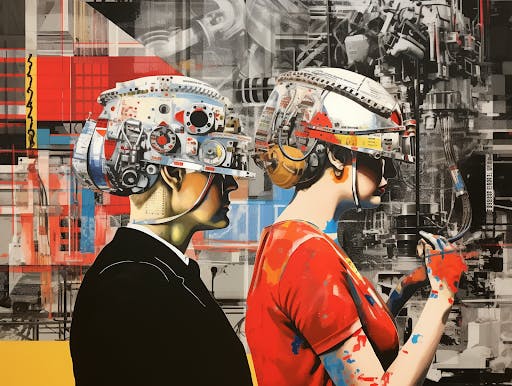Some metaverse critics point to the significant decline in the NFT market and giant tech companies like Facebook and Microsoft scaling back their metaverse investments as evidence that the metaverse ambition is overblown and destined to fail.
While it is true that VC funding for metaverse projects experienced a massive decline between 2021 and 2022, likely caused by the crypto market crash, there is no doubt whatsoever that the metaverse is still part of a unique series futuristic technologies whose long-term potential continues to attract investors.
The metaverse’s potential to create a rich immersive digital experience, fostering a more interconnected world, is all but dead. The recovery of the crypto market in 2024 presents a tailwind and the long-term success of the metaverse still depends on its ability to overcome technical obstacles and user adoption.
Any technology designed to push the boundaries of real socialization is bound to hit critical mass simply because technology dependency rates have increased significantly in the past two decades, forming the basis of human interaction and the rise of revolutionary technologies such as AI, VR , AR, etc.
With the metaverse, a VR-based technology, on the horizon, the human digital experience will not only undergo a rebrand, but also replace the existing infrastructure on which our digital world is built, extending beyond social media. Because the metaverse promises a diverse digital world with endless possibilities, it quickly caught the world’s attention and reached its fever pitch in 2021 with Facebook announcing that it had changed its company name to Meta.
The Facebook name change was a defining moment in the development of the metaverse, as its main competitors such as Google and Microsoft also took the initiative to launch their own metaverse projects, promising to usher in a future where we can work, play and conduct business activities in an immersive 3D environment.
The concept of the metaverse being very attached to crypto space means that it is susceptible to the prevailing market sentiments. For example, despite the decline seen in 2022, data from DappRadar showed that venture capital companies invested $707 million in metaverse projects in the first half of 2023.
However, violent bear markets can also take a significant toll on the development of the metaverse as happened in 2022 when funding for the metaverse space plummeted by 87% from its exuberant peak of 2021, indicating a major drop in investor confidence.
Around this time, Facebook’s metaverse projects called “Horizon Worlds” faced challenges with reports suggesting low user engagement and technological setbacks, contributing to the overall decline in investor confidence for metaverse projects through the year 2022.
Although the broader crypto winter and technological hurdles likely played a bigger role, some critics believed that the Metaverse dream died with Facebook spending billions of dollars on its project that failed to produce any tangible results.
Speaking to the UK Guardian, Rachel Foster Jones, a thematic analyst, criticized Facebook’s Horizon Worlds: “The cost of Mark Zuckerberg’s metaverse ambition is clearer than ever. Meta staked its entire business on the metaverse, which still doesn’t exist, and the gamble isn’t paying off. Meta was too busy trying to bury the metaverse that it was operating its core advertising business, and a string of poor results demanded investor confidence.”
With the crypto market experiencing a recovery fueled by significant milestones such as the approval of the Bitcoin ETFs, there is now a clear indication that the metaverse hype has finally died down. Although challenges still remain, the crypto industry has become more resilient and stricter regulatory oversight is helping to build a more complaint-friendly ecosystem for potential investors.
In retrospect, the hype was worth it and the enduring potential of the metaverse implied that a decline in funding was nothing more than a temporary setback. Nowhere is this more evident than in the fact that today the metaverse is entering a more realistic phase of growth. With the initial excitement over, the focus shifted to building its infrastructure and overcoming its real world challenges.
According to the Digital Watch Observatory’s 2024 forecast: “The evolution of the metaverse stands at the intersection of technology and human imagination. Projections for 2024 indicate a potential leap forward, albeit rooted in continued advances in AI, but also in the development of high-quality chips that will provide much-needed computing power. Our bet is still on the long-term success of metaverse. After the initial hype, practical applications will characterize the years to come.”
CIZ VERS As a case study
To further illustrate the evolving dynamics of the metaverse and its intersection with emerging technologies such as AI and blockchain, we will take a brief look at CIZ VERSE, an open source metaverse project aimed at launching the first Bitcoin powered metaverse.
The core of this project is a decentralized metaverse layer that blends blockchain technology with AI functionality to enhance asset creation from its repository of multimedia, including images and video.
CIZ Verse using AI is an example of the practical applications that the Digital Watch Observatory predicted will “mark the coming years” in the development of the metaverse, especially as it seeks to create a vast virtual environment filled with user-generated AI content creation expanding the capabilities of the Bitcoin ecosystem.
In addition, its decentralization model will enable it to function as an open platform where users can create, meet, interact and transact and its mix of business and pleasure enables it to combine commerce with mini-games, hangouts and social characteristics. Finally, as a Bitcoin-powered metaverse, it is primarily aimed at a wide range of users, including Web3 natives, gamers, developers, and metaverse fans, and as its open world develops and user-generated content grows, it will certainly continue to ‘ provide a host. of use cases and features including NFTs, RWAs and DeFi.
Deduction
The metaverse in 2024 presents a picture of a renewed focus on its development within and beyond the crypto space. The initial frenzy surrounding it has gradually been replaced by a new approach aimed at overcoming technical barriers and building a solid foundation.
Disclaimer for Uncirculars, with a Touch of Personality:
While we love diving into the exciting world of crypto here at Uncirculars, remember that this post, and all our content, is purely for your information and exploration. Think of it as your crypto compass, pointing you in the right direction to do your own research and make informed decisions.
No legal, tax, investment, or financial advice should be inferred from these pixels. We’re not fortune tellers or stockbrokers, just passionate crypto enthusiasts sharing our knowledge.
And just like that rollercoaster ride in your favorite DeFi protocol, past performance isn’t a guarantee of future thrills. The value of crypto assets can be as unpredictable as a moon landing, so buckle up and do your due diligence before taking the plunge.
Ultimately, any crypto adventure you embark on is yours alone. We’re just happy to be your crypto companion, cheering you on from the sidelines (and maybe sharing some snacks along the way). So research, explore, and remember, with a little knowledge and a lot of curiosity, you can navigate the crypto cosmos like a pro!
UnCirculars – Cutting through the noise, delivering unbiased crypto news















